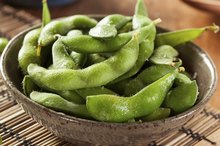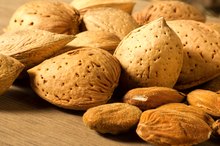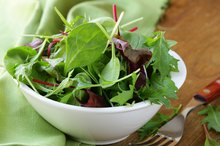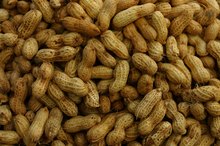Foods With Calcium Channel Blockers
Calcium channel blockers, or calcium antagonists, are so named because they block calcium from going into blood vessel and heart cells. This helps to relax and widen artery walls. They are used in the treatment of conditions such as hypertension, migraine headaches, arrhythmias and certain other circulatory problems. As reported by Dr. Lloyd T. Iseri and Dr. James H. French in an editorial in the American Heart Journal, magnesium acts as a natural calcium antagonist, preventing negative effects of calcium excess, but unlike synthetic calcium blockers, magnesium enhances the activity of calcium. Eating foods high in magnesium can boost your levels, blocking excess calcium in a natural way.
Vegetables
According to the National Institute of Health, magnesium is a mineral necessary for over 300 biochemical reactions in your body. It is involved with healthy muscle and nerve function, keeps your heartbeat steady, assists your immune system and plays a role in bone strength. Several vegetables contain high levels of magnesium, including artichokes, black, navy and white beans, soybeans, squash, broccoli and tomato paste. The chlorophyll molecules in green vegetables such as beet greens, spinach and Swiss chard contain magnesium, making these nutrient-rich leaves an excellent choice for increasing your magnesium levels.
- According to the National Institute of Health, magnesium is a mineral necessary for over 300 biochemical reactions in your body.
- The chlorophyll molecules in green vegetables such as beet greens, spinach and Swiss chard contain magnesium, making these nutrient-rich leaves an excellent choice for increasing your magnesium levels.
Grains
Does Magnesium Help You Lose Weight?
Learn More
In addition to ameliorating the negative effects of excess calcium in your body, magnesium can help modulate your blood sugar level and also plays a role in the metabolism of energy and in making proteins, according to the Linus Pauling Institute. Grains offer one of the most concentrated sources of magnesium found in foods. The bran, or outer coating of the seed, is the repository for much of the magnesium in grains, so refined and processed grains offer little benefit. Some of the best sources include pearled raw barley, raw oat or wheat bran, whole wheat flour and cornmeal. Buckwheat is often used as a grain substitute and is especially rich in this important mineral. Eating a diet that includes whole grains will also increase your intake of dietary fiber.
- In addition to ameliorating the negative effects of excess calcium in your body, magnesium can help modulate your blood sugar level and also plays a role in the metabolism of energy and in making proteins, according to the Linus Pauling Institute.
- The bran, or outer coating of the seed, is the repository for much of the magnesium in grains, so refined and processed grains offer little benefit.
Nuts and Seeds
According to a large national survey by the Institute of Medicine in 1997, average magnesium intake for both men and women is far less than the Recommended Daily Allowance, or RDA. Several varieties of seeds and nuts make good snacks, and when included as crunchy additions to your favorite recipes, you can boost your consumption of magnesium, good fats, and other important vitamins and minerals. Seeds high in magnesium include sunflower, sesame and pumpkin seeds. Almonds, Brazil nuts, hazelnuts, pine nuts, and cashews are all nuts with high magnesium content. Peanuts are also a good source of magnesium, but are actually in the legume family and are not considered true nuts.
- According to a large national survey by the Institute of Medicine in 1997, average magnesium intake for both men and women is far less than the Recommended Daily Allowance, or RDA.
- Almonds, Brazil nuts, hazelnuts, pine nuts, and cashews are all nuts with high magnesium content.
Related Articles
References
- MayoClinic.com: Calcium Channel Blockers
- Vaughn's Summaries: High Magnesium Foods
- Oregon State University, Linus Pauling Institute: Magnesium
- "Magnesium. Dietary Reference Intakes: Calcium, Phosphorus, Magnesium, Vitamin D, and Fluoride"; Food and Nutrition Board, Institute of Medicine; National Academy Press; 1997
- Rosanoff, A., Weaver, C. M., & Rude, R. K. (2012). Suboptimal magnesium status in the United States: are the health consequences underestimated?. Nutrition Reviews, 70(3), 153-164.
- Dupont, C., Campagne, A., & Constant, F. (2014). Efficacy and safety of a magnesium sulfateârich natural mineral water for patients with functional constipation. Clinical Gastroenterology and Hepatology, 12(8), 1280-1287.
- D'Angelo, E. K., Singer, H. A., & Rembold, C. M. (1992). Magnesium relaxes arterial smooth muscle by decreasing intracellular Ca2+ without changing intracellular Mg2+. The Journal of Clinical Investigation, 89(6), 1988-1994.
- Sojka, J. E. (1995). Magnesium supplementation and osteoporosis. Nutrition Reviews, 53(3), 71-74.
Resources
Writer Bio
Paul Elsass started writing in 1986. He has written articles for the Clinical Exercise Physiology Association and multiple medical-fitness centers. Elsass has certifications through the American College of Sports Medicine and the American Council on Exercise. He holds a Bachelor of Science in Kinesiology from the University of Texas and a Master of Science in Management from Northern Arizona University.









